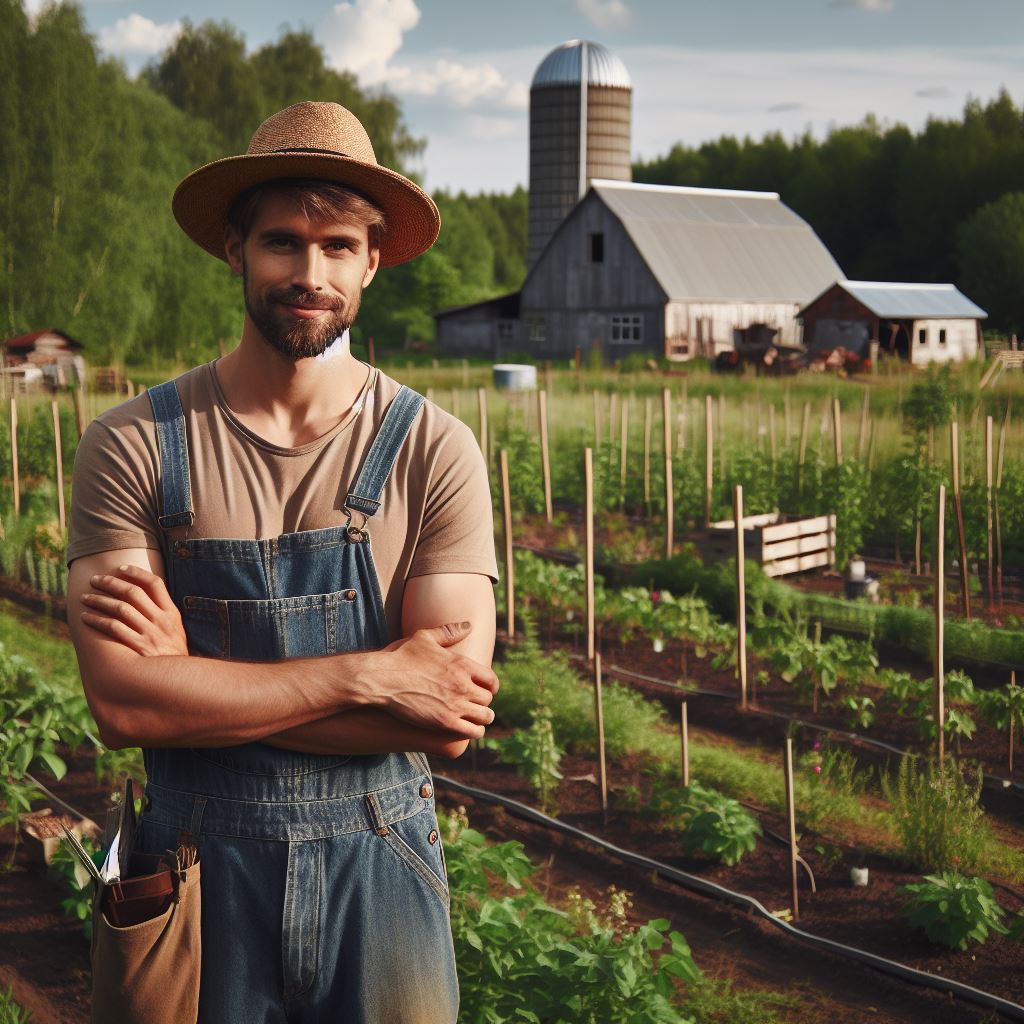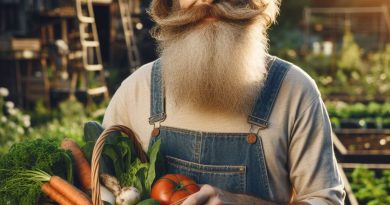Perennial Crops for Sustainable Yield
Last Updated on February 1, 2024
Introduction
Sustainable agriculture is crucial for ensuring food security and environmental conservation. Perennial crops play a vital role in achieving sustainable yield.
Perennial crops are plants that live for more than two years and do not require annual replanting.
These crops have numerous benefits, including soil preservation, improved biodiversity, and reduced water and chemical use.
Additionally, perennial crops provide long-term economic stability, as they require less labor and input costs.
Furthermore, these crops enhance carbon sequestration, mitigating climate change effects.
By maintaining a permanent root system, perennial crops prevent soil erosion and nutrient runoff, improving soil health.
They also offer habitat and food for wildlife, promoting ecological balance and biodiversity conservation.
Perennial crops include trees, shrubs, and grasses, such as apples, grapes, asparagus, and switchgrass.
These crops have extensive root systems that increase soil organic matter and nutrient availability.
Moreover, they have the potential to provide a year-round food supply, reducing the need for seasonal planting.
In short, perennial crops are essential for sustainable agriculture, as they contribute to soil conservation, environmental conservation, and economic stability.
Benefits of Perennial Crops
Perennial crops offer several benefits that make them a sustainable choice for farmers and the environment. These crops provide long-term benefits through reduced soil erosion, increased carbon sequestration, improved water retention, and enhanced biodiversity.
- Reduced soil erosion: Perennial crops have deep root systems that hold the soil together, preventing erosion caused by wind and water. Unlike annual crops, which are replanted every year, perennial crops stay in the ground, providing continuous protection to the soil.
- Increased carbon sequestration: Perennial crops have extensive root systems that sequester carbon dioxide from the atmosphere. These deep roots can reach carbon-rich layers of the soil, storing carbon for longer periods compared to annual crops. This helps mitigate climate change by reducing greenhouse gas emissions.
- Improved water retention: The deep root systems of perennial crops enable them to absorb and store water more efficiently. This reduces water runoff and improves the soil’s ability to retain moisture. As a result, farmers growing perennial crops require less irrigation, conserving water resources.
- Enhanced biodiversity: Perennial crops create a more diverse and resilient ecosystem. Their long-term presence provides a stable habitat for a variety of plants, insects, and animals. This biodiversity not only supports a healthier ecosystem but also promotes natural pest control, reducing the need for synthetic pesticides.
Perennial crops have the potential to revolutionize agriculture and promote long-term sustainability.
By integrating these crops into farming practices, farmers can reap numerous benefits.
Reduced soil erosion
One of the key advantages of perennial crops is their ability to reduce soil erosion significantly.
With their deep and extensive root systems, these crops anchor the soil and prevent it from being washed away by heavy rainfall or carried away by strong winds.
This helps maintain soil fertility and prevents nutrient loss, ensuring sustained and productive farming.
Increased carbon sequestration
Moreover, perennial crops excel at carbon sequestration. The deep roots of these plants lock carbon dioxide underground, effectively offsetting greenhouse gas emissions.
As a result, growing perennial crops can help mitigate climate change by reducing the carbon footprint of agriculture.
Improved water retention
In addition to carbon sequestration, perennial crops also improve water retention in the soil.
Their extensive roots enable them to access deeper soil layers, accessing more water reserves.
This ability to store water reduces the need for frequent irrigation, making farming more sustainable, especially in water-scarce regions.
Enhanced biodiversity
Furthermore, the presence of perennial crops nurtures biodiversity in and around farmlands.
These crops provide a stable habitat for a wide range of plant and animal species.
The diverse ecosystem created by perennial crops supports natural pollination, control of pests, and soil health.
This reduces the reliance on synthetic pesticides and fertilizers, fostering a more ecologically balanced farming system.
By choosing perennial crops, farmers embrace sustainable practices that benefit both the environment and their own livelihoods.
The reduced soil erosion, increased carbon sequestration, improved water retention, and enhanced biodiversity associated with perennial crops contribute to healthier ecosystems, improved soil quality, and higher agricultural yields.
In fact, the benefits of perennial crops cannot be overlooked.
These crops offer long-term ecological and economic advantages, such as reduced soil erosion, increased carbon sequestration, improved water retention, and enhanced biodiversity.
As the demand for sustainable farming practices grows, the adoption of perennial crops becomes crucial for a more resilient and environmentally friendly agriculture sector.
Read: Creating Microclimates in Permaculture
Examples of Perennial Crops
When it comes to sustainable agriculture, perennial crops play a crucial role in ensuring a continuous and sustainable yield.
These crops do not require replanting every year, which reduces soil erosion and promotes long-term soil health.
In this section, we will explore some examples of perennial crops and their various aspects.
Apples
Apples are one of the most popular perennial crops, with apple orchards being a common sight in many regions.
These orchards provide numerous benefits, including air purification, erosion control, and wildlife habitat. Varieties suitable for different regions ensure optimal production in various climates.
Apples require regular maintenance, such as pruning and fertilization, and specific harvesting techniques to ensure proper yield.
Almonds
Almonds are another perennial crop that offers several advantages. Almond trees are drought-tolerant and can thrive in arid regions.
Suitable growing conditions include well-drained soils and mild winters.
However, pest and disease management is crucial for successful almond cultivation.
Proper harvesting and processing methods ensure the production of high-quality almonds, which can be consumed as nuts or used in various culinary applications.
Bamboo
Bamboo, known for its versatility and usefulness, is gaining popularity as a perennial crop.
It can be used for construction, furniture, paper production, and even as a food source. Bamboo cultivation requires suitable climates, with tropical and subtropical regions being ideal.
Sustainable harvesting practices, such as selective cutting and regrowth promotion, ensure a continuous supply of bamboo.
The potential products and applications make bamboo a valuable crop for sustainability.
Grapes
Grapes, particularly in the form of vineyards, also contribute to sustainable agriculture.
Vineyards support biodiversity and provide habitat for various organisms.
Popular grape varieties, such as Cabernet Sauvignon and Chardonnay, thrive in specific climates and soil conditions.
Wine production is a significant economic aspect associated with grapes, promoting local industries and tourism.
Maintaining optimal climate and soil requirements is crucial for successful grape cultivation and wine production.
In essence, there are several examples of perennial crops that contribute to sustainable yield in agriculture.
Apples, almonds, bamboo, and grapes are just a few of the many options available.
Each crop has unique characteristics, benefits, and requirements, ranging from maintenance and pest management to suitable climates and harvesting techniques.
By incorporating these perennial crops into agricultural practices, we can promote sustainable agriculture and ensure a continuous and environmentally friendly yield.
Read: Integrating Livestock in Eco-Farming
Challenges in Growing Perennial Crops
Perennial crops are widely recognized for their sustainability and long-term benefits. However, there are several challenges that farmers face when growing these crops.
In this blog section, we will explore the main challenges in growing perennial crops and how farmers can overcome them.
Longer establishment time
Growing perennial crops requires a longer establishment period compared to annual crops.
This means that farmers have to be patient and wait for the crops to develop a well-established root system before they can expect a significant yield.
This can be a challenge for farmers who are used to the faster growth and shorter time frame of annual crops.
Initial investment and financial considerations
Establishing perennial crops often requires a higher initial investment compared to annual crops.
Farmers need to invest in quality planting material, such as healthy seedlings or rootstocks.
Additionally, there is a need for land preparation, irrigation infrastructure, and pest control measures.
This initial financial burden can be a challenge for farmers, especially those with limited resources.
Potential yield variations
Perennial crops are subjected to yield variations due to climate variations, disease outbreaks, or natural events like frost or drought.
Unlike annual crops, which can be replanted every year, perennial crops require continuous care and management throughout their lifetime.
Farmers need to be prepared for these variations and have contingency plans in place to minimize the impact on their yield.
Maintenance and pest management challenges
Perennial crops demand constant maintenance, including pruning, fertilization, weed control, and pest management.
Unlike annual crops that are harvested and removed from the field each year, perennial crops remain in the field year after year, making them more susceptible to pest and disease infestation.
Farmers need to employ integrated pest management strategies to mitigate these challenges and protect their crops.
Overcoming the challenges
Seek expert guidance and knowledge
Farmers should consult experts, agricultural extension services, or fellow farmers experienced in growing perennial crops.
Their guidance can provide valuable insights and help overcome challenges related to establishment, maintenance, and pest management.
Financial planning and support
Farmers can explore various financing options to cope with the initial investment required for growing perennial crops.
Government grants, agricultural loans, and cooperative funding can be sought to alleviate the financial burden.
Diversify crops and practices
To minimize the impact of potential yield variations, farmers can diversify their crop portfolio and adopt multiple cropping systems.
This will spread the risk and ensure a more stable income. Additionally, implementing sustainable agricultural practices like soil conservation, crop rotation, and improved irrigation systems can enhance crop resilience and yield potential.
Continuous learning and adaptation
Keeping up with the latest research, developments, and technological advancements in perennial crop production is crucial.
Farmers should attend workshops, conferences, and training programs to update their knowledge and learn about innovative practices that can help overcome challenges.
Adaptation and flexibility are key in successfully growing perennial crops.
In brief, while perennial crops offer sustainable benefits, they come with their own set of challenges.
Longer establishment time, initial investment, potential yield variations, and maintenance and pest management challenges require careful planning and management.
By seeking expert advice, financial planning, diversifying crops and practices, and continuous learning, farmers can overcome these challenges and achieve sustainable yields from perennial crops.
Read: Natural Building: Permaculture Approach

Promoting Perennial Crops for Sustainable Yield
Perennial crops offer numerous benefits, such as improved soil health, reduced use of synthetic inputs, and long-term productivity.
However, their adoption is often hindered by several factors. To promote the cultivation of perennial crops and ensure sustainable yield, the following measures can be taken:
Government incentives and support
- Offer financial incentives to farmers who transition to perennial crop production.
- Provide tax breaks and subsidies for the cultivation, processing, and distribution of perennial crops.
- Allocate funds for research and development of perennial crop varieties suitable for different regions.
- Establish policies that prioritize perennial crops in government procurement and food security programs.
Education and awareness campaigns
- Organize workshops and training programs to educate farmers about the benefits and techniques of perennial crop cultivation.
- Create educational materials, such as brochures and videos, to raise awareness among farmers and consumers.
- Collaborate with agricultural extension services to integrate perennial crop information into existing farmer outreach programs.
- Engage schools and universities in promoting the importance of perennial crops through curriculum development and student involvement.
Collaboration with research institutions
- Establish partnerships between research institutions and farmers to develop innovative techniques and practices for perennial crop cultivation.
- Conduct joint research projects to improve the yield, disease resistance, and nutritional value of perennial crops.
- Share research findings and best practices through workshops, conferences, and scientific publications.
- Create platforms for knowledge exchange and networking among farmers, scientists, and policymakers.
Market demand and consumer awareness
- Promote the nutritional benefits and unique flavors of perennial crops through marketing campaigns.
- Encourage chefs, restaurants, and food businesses to incorporate perennial crops into their menus and products.
- Establish labeling and certification programs to differentiate products made from perennial crops in the marketplace.
- Partner with retailers and supermarkets to increase the availability and visibility of perennial crop-based products.
By implementing these strategies, the cultivation of perennial crops can be significantly boosted, leading to sustainable yield and a more resilient agricultural system.
Governments, educational institutions, researchers, and consumers all have a crucial role to play in supporting and promoting the adoption of perennial crops.
Read: Soil Regeneration: Basics and Benefits
Conclusion
Perennial crops offer numerous benefits that contribute to sustainable agriculture and the well-being of future generations.
By choosing perennial crops, farmers can enjoy increased yield stability, reduced soil erosion, and improved nutrient cycling.
Additionally, these crops require less labor, water, and fertilizer inputs, which can lead to cost savings for farmers in the long run.
Furthermore, the extensive root systems of perennial crops help sequester carbon from the atmosphere, mitigating climate change.
To fully embrace the potential of perennial crops, it is essential for farmers to consider incorporating them into their agricultural practices.
By doing so, they can experience improved soil health, increased biodiversity, and enhanced ecological services.
As stewards of the land, it is our responsibility to prioritize long-term sustainable agriculture.
By adopting perennial crops, we can ensure the fertility and productivity of our farmland, while safeguarding the health of our ecosystems for future generations.
Therefore, I urge all farmers to take action today and explore the possibilities of including perennial crops in their crop rotation systems.
Let us work together towards a more sustainable and resilient agriculture that will benefit not only ourselves but also the generations to come.


